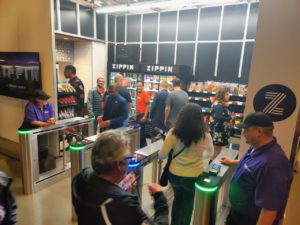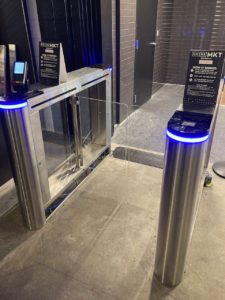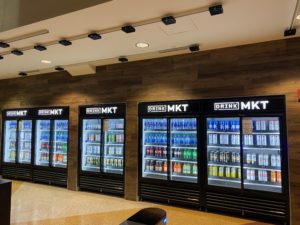
A Zippin-powered checkout-free concessions stand at Golden 1 Center in Sacramento in 2019. Credit: Zippin/Sacramento Kings (click on any photo for a larger image)
At the Sacramento Kings’ Golden 1 Center and at Empower Field at Mile High in Denver, trial concession stands powered by Zippin have already opened and been used by fans, both before the pandemic (in Sacramento) and during the past season at Empower Field, where the Denver Broncos had some games this fall with limited fan attendance.
The checkout-free store idea, pioneered by Amazon a few years ago, uses pre-visit payment information (collected either via an app or a credit-card swipe before entry) and a combination of in-store recognition technology — usually a mix of cameras, weight sensors and artificial intelligence software — to “see” what customers are taking off the shelves, and to charge the customers for those items as they leave the store.
While many customers are amazed the system actually works even after they leave a store, the potential checkout-free systems have to solve one of the biggest pain points of stadium visits — waiting in line for concessions — has generated considerable interest among venue owners and operators. And with transaction times in both Sacramento and Denver averaging less than a minute — and some in Sacramento as quick as 10 seconds — it’s a also good bet that fans will quickly embrace more checkout-free operations so that they can get back to their seats to watch the event they paid to attend.
Fans can’t believe it works
“It’s so intriguing to watch a fan go through the [checkout-free] process, and see how they react,” said Jay Morrison, district manager for Aramark, the concessionaire at Empower Field. At one of the Broncos games this fall Morrison was watching fans exit the Zippin-powered concession stand “and they would look around, sort of stand there and say that they can’t believe it,” Morrison said. And then, of course, the fans would share the experience on social media.
“In all my years of being in F&B, I’ve never seen somebody taking a picture of somebody buying a soda,” Morrison said.
While Amazon may have pioneered the checkout-free idea when it opened its first Amazon Go store in 2018, the market now has a growing number of startups seeking to become the back-end suppliers. But Zippin, a San Francisco-based startup with 50+ employees and $15 million in venture funding, is the first to crack into the stadium concessions market, an area that seems ripe for such innovation, especially given the new reality of supporting concession operations during a pandemic.In Denver, Aramark had already decided to trial the Zippin technology at Mile High well before the pandemic put a premium on less human contact for transactions.
“The unintended benefit is that [checkout-free] fits perfectly with Covid and beyond,” said Aramark’s Morrison.
John Rinehart, president for business operations with the Sacramento Kings, noted that the Zippin system’s entry gate inherently delivers a way to enforce social distancing by limiting capacity inside the store as necessary.
Getting fans back to their seats
Like in Denver, Sacramento had decided to try the Zippin system well before the pandemic hit — at Golden 1 Center a Zippin-powered store was opened in September in 2019, as part of what Rinehart said is a continued desire to use technology to improve the fan experience.
“It’s kind of in our DNA to look out for these things,” said Rinehart of the arena that opened in 2016 with some of the most advanced wireless networking and display technologies, as well as one of the most innovative stadium apps.
At Golden 1 Center, the Zippin store was an open area on the main concourse, and in addition to coolers with drinks it also had an assortment of snacks, as well as a way to use Zippin to pay for hot food items like popcorn or pizza. According to Rinehart a customer would purchase a ticket for the hot items inside the Zippin store, and then go next door to a hot-food stand where their order would be fulfilled.In Denver, Aramark added the Zippin technology to one the “Drink Market” stands it had opened at the stadium the year before, which were basically walk-through stands with self-serve glass-door drink coolers. In 2019, those stands used a unique visual-scanner system from Mashgin where fans would place items to be scanned and priced. The only staffing needed was one person at the end of the line to check IDs and to open cans and bottles before fans left.
With the Zippin technology, fans can either download an app or use their credit cards at the entry gate. Once they are authorized, they enter the store, select their items and simply walk out through the exit gate (again, where they would encounter one staffer for ID check and bottle/can opening).
According to Aramark’s Morrison, having support both for an app as well as walk-up credit card access was a key selling point for Zippin, since many fans have historically proven “resistant” to downloading and registering through an app.
While education on how the store works is necessary — in Denver and Sacramento both stadiums had signage as well as email instructions for the systems — Morrison also said that fans seem to learn the system quickly and are happy to tell others how it works.
And in both stadiums, operators saw fans coming back for repeated visits during a single game, since they knew they wouldn’t have to wait long.
“If you know what you want, you can get in and out in less than 10 seconds,” said the Kings’ Rinehart. Both Denver and Sacramento operators said they saw average visit times of around 45 seconds, an unthinkable speed for anyone who’s ever spent an entire baseball inning or half a football quarter waiting for a hot dog and a beer.
Minimal reconfiguration needed
According to Zippin CEO Krishna Motukuri, the Zippin-powered stands don’t need a lot of technology or networking support. The camera systems, he said, only use about 15-to-20 Mbps of network bandwidth, and the AI computations are done on the edge modules Zippin installs on the site.
Motukuri said Zippin operates under a software-as-a-service module, charging venue owners and operators a monthly fee and a per-transaction fee. According to Aramark’s Morrison the cost of a Zippin deployment is far cheaper than buying similar technology from Amazon, which Aramark had initially considered.At Golden 1 Center Rinehart said the Zippin system was fairly easy to deploy, since the open-concourse setting allowed them to bring cameras down from above. In Denver, Aramark and the Broncos actually had to raise the ceiling on the area used, so that the Zippin cameras could have a better range of focus.
And according to Aramark’s Morrison the Zippin system reduced the needed real estate for checkout, using less than a third of the space required by the Mashgin systems. “That let us put four more beverage coolers into the space,” Morrison said. In addition to the cameras, a Zippin system also requires entry and exit gates, as well as sensors for all shelves holding items.
Using the pandemic to ‘leapfrog’ to the future
Zippin’s Motukuri, who founded the company in 2015, said that the Covid pandemic has exposed some of the issues that still plague other concession systems, the fact that there still may be a wait to purchase items.
“Self-checkout doesn’t get rid of lines,” Motukuri said. “Our system is not just frictionless, it’s contactless. It offers venues an opportunity to leapfrog ahead.” According to Zippin, a new Zippin-powered concession stand is set to open at the San Antonio Spurs’ AT&T Center when fans are allowed back in that building.
In Denver, Aramark’s Morrison said that the speed enabled by the Zippin system was part of the process that allowed the venue to re-open with limited attendance.
“The state of Colorado [regulators] observed us, and we had to deliver on the commitment [to safer operations],” Morrison said. “Having the self-order system was part of what enabled us to get back to having fans.”
(Zippin promotional video below)








